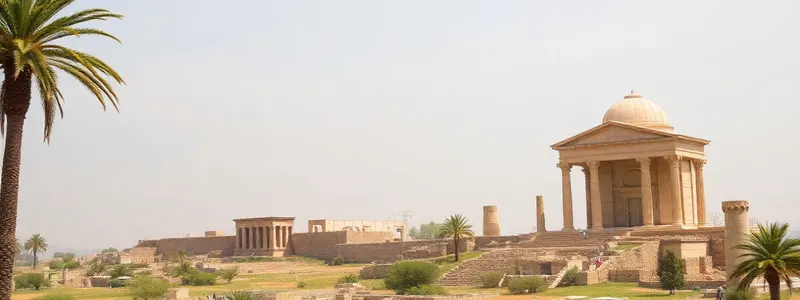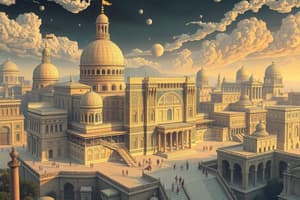Podcast
Questions and Answers
What is the definition of a "Cradle of Civilization"?
What is the definition of a "Cradle of Civilization"?
A Cradle of Civilization refers to locations where civilizations are believed to have emerged, according to current archaeological evidence.
Which two rivers are Mesopotamia known as "the land between"?
Which two rivers are Mesopotamia known as "the land between"?
Tigris and Euphrates
What geographic zones make up Ancient Egypt?
What geographic zones make up Ancient Egypt?
the Delta, the Western Desert, the Eastern Desert, and the Nile Valley
The Indus Valley Civilization was located in the south-eastern region of the Indian subcontinent.
The Indus Valley Civilization was located in the south-eastern region of the Indian subcontinent.
Ancient China developed along the Yellow River.
Ancient China developed along the Yellow River.
What are the three parts that Ancient Greece was divided into?
What are the three parts that Ancient Greece was divided into?
What River did Rome start as a small village on?
What River did Rome start as a small village on?
What form of religion did the Mesopotamians practice?
What form of religion did the Mesopotamians practice?
Flashcards
Cradle of Civilization
Cradle of Civilization
A term referring to locations where civilizations emerged, based on archaeological evidence.
Mesopotamia: Geographic Setting
Mesopotamia: Geographic Setting
The area between the Tigris and Euphrates rivers, known for its fertile land and early civilizations.
Egypt: Geographic Setting
Egypt: Geographic Setting
Ancient Egypt was located in northeastern Africa, with four distinct geographical zones: the Nile Valley, the Delta, the Western Desert, and the Eastern Desert.
Indus Valley: Geographic Setting
Indus Valley: Geographic Setting
Signup and view all the flashcards
China: Geographic Setting
China: Geographic Setting
Signup and view all the flashcards
Greece: Geographic Setting
Greece: Geographic Setting
Signup and view all the flashcards
Rome: Geographic Setting
Rome: Geographic Setting
Signup and view all the flashcards
Mesopotamia: Religion
Mesopotamia: Religion
Signup and view all the flashcards
Egypt: Religion
Egypt: Religion
Signup and view all the flashcards
Indus Valley: Religion
Indus Valley: Religion
Signup and view all the flashcards
China: Religion
China: Religion
Signup and view all the flashcards
Greece: Religion
Greece: Religion
Signup and view all the flashcards
Rome: Religion
Rome: Religion
Signup and view all the flashcards
Mesopotamia: Government
Mesopotamia: Government
Signup and view all the flashcards
Egypt: Government
Egypt: Government
Signup and view all the flashcards
Indus Valley: Government
Indus Valley: Government
Signup and view all the flashcards
China: Government
China: Government
Signup and view all the flashcards
Greece: Government
Greece: Government
Signup and view all the flashcards
Rome: Government
Rome: Government
Signup and view all the flashcards
Mesopotamia: Writing
Mesopotamia: Writing
Signup and view all the flashcards
Egypt: Writing
Egypt: Writing
Signup and view all the flashcards
Indus Valley: Writing
Indus Valley: Writing
Signup and view all the flashcards
China: Writing
China: Writing
Signup and view all the flashcards
Greece: Writing
Greece: Writing
Signup and view all the flashcards
Rome: Writing
Rome: Writing
Signup and view all the flashcards
Mesopotamia: Spread of Culture
Mesopotamia: Spread of Culture
Signup and view all the flashcards
China: Spread of Culture
China: Spread of Culture
Signup and view all the flashcards
Rome: Spread of Culture
Rome: Spread of Culture
Signup and view all the flashcards
Mesopotamia: Contributions
Mesopotamia: Contributions
Signup and view all the flashcards
Egypt: Contributions
Egypt: Contributions
Signup and view all the flashcards
Indus Valley: Contributions
Indus Valley: Contributions
Signup and view all the flashcards
China: Contributions
China: Contributions
Signup and view all the flashcards
Greece: Contributions
Greece: Contributions
Signup and view all the flashcards
Rome: Contributions
Rome: Contributions
Signup and view all the flashcards
Study Notes
Cradle of Civilization
The "Cradle of Civilization" refers to various regions in the world where the first complex societies emerged, characterized by the development of agriculture, urban centers, and systemic governance. This concept is deeply rooted in archaeological evidence and historical research that highlights the essential contributions of these early civilizations to human progress. Key factors that contributed to the development of these civilizations include the geographical landscape, religious beliefs, governance structures, writing systems, cultural diffusion, and impactful historical events that shaped their development over time.
Mesopotamia: Often referred to as "the land between two rivers," Mesopotamia is situated between the Tigris and Euphrates Rivers, within the modern borders of Iraq and parts of Syria and Turkey. It features a semi-arid climate that necessitated advanced irrigation systems, which were meticulously engineered by around 6000 BCE to support agriculture. This innovation led to the growth of cities such as Ur and Babylon, anchoring trade and culture in the region.
Egypt: The ancient civilization of Egypt, located in Northeastern Africa, is defined by its four distinctive geographic zones: the fertile Nile Delta, the arid Western Desert, the rugged Eastern Desert, and the life-sustaining Nile Valley. The Nile River played a crucial role in agriculture, trade, and transportation, fostering one of the most enduring cultures in human history through monumental architecture, religious practices, and writing, including hieroglyphics.
Indus: The Indus Valley Civilization, which flourished in northwestern India and what is now Pakistan, emerged around 2500 BCE along the Indus River. Known for its advanced urban planning, sanitation systems, and trade, this civilization showcased significant sociocultural development, evidenced by well-organized cities like Mohenjo-Daro and Harappa.
China: The early civilizations of ancient China developed predominantly along the Yangtze and Yellow Rivers, which provided fertile land crucial for agriculture and food security. These rivers also served as vital conduits for trade and communication, enabling the exchange of ideas and innovations. Chinese civilization is marked by major advancements in areas such as philosophy, governance, and writing, contributing to a rich cultural heritage that has persisted through millennia.
Greece (Geographic Setting)
- Greece is located in the northeastern part of the Mediterranean Sea, occupying the lower part of the Balkans.
- It's divided into three regions: Peloponnese, Central Greece, and Northern Greece.
Rome (Geographic Setting)
- Rome originated as a small village near the Tiber River on the Italian Peninsula.
- It is located close to the Mediterranean Sea.
- The region is characterized by the Alps and Apennine mountain ranges.
Mesopotamia (Religion)
- Mesopotamian religion was polytheistic, worshipping numerous gods, including some major deities and many minor ones; it was also henotheistic at times.
- The three main gods were Ea (wisdom and magic), Anu (sky god), and Enlil (earth, storms, and agriculture).
Egypt (Religion)
- Egyptian religion was also polytheistic, involving the worship of numerous gods. It was also henotheistic at times.
- Major gods included Re (sun-god), god of the dead, and Osiris.
- During the Old Kingdom, kings added "Son of Re" to their royal titles.
Indus (Religion)
- The religion of the Indus Valley Civilization is a debated topic, remaining speculative.
- Interpretations of Harappan culture suggest that features of later Hinduism might have existed 4,000 years ago.
China (Religion)
- Confucianism, Taoism, and Buddhism are considered the "three pillars" of ancient Chinese society.
- Key figures associated with each include Confucius for Confucianism, Lao Tzu for Taoism, and Siddhartha Gautama for Buddhism.
Greece (Religion)
- Ancient Greeks believed in gods involved in all aspects of life, including work, theater, justice, politics, marriage, and war. There was no separation between religious and state entities.
- Greek religion was polytheistic, with twelve major deities, forming the Greek pantheon. These include Zeus, Hades, Poseidon, Hera, Athena, Apollo, Artemis, Aphrodite, Dionysos, Ares, Hephaestus, and Hermes.
Rome (Religion)
- Roman religion involved a belief in mythological gods and creatures.
- Later, a monotheistic concept emerged — the belief in a single god.
Mesopotamia (Government)
- Government was based on undivided sovereignty under a single ruler.
- Enmebaragesi, the penultimate king of the first dynasty of Kish, reigned for 900 years according to the Sumerian King List.
Egypt (Government)
- Egypt's government was a theocratic monarchy.
- The king, often called the pharaoh, was viewed as a representative of a god.
- King Menes was the legendary first king of unified Egypt.
Indus (Government)
- The Indus Valley's government was a theocracy, ruled by powerful priests-kings.
- Like the Sumerian and Egyptian civilizations, religious authority dictated governance.
- Kings during this era were called rajas.
China (Government)
- China operated under an absolute monarchy, where the emperor held unquestioned authority.
- Qin Shi Huang was the first emperor of China, establishing the Qin dynasty.
- The title "Emperor" was the highest held by Chinese monarchs throughout history.
Greece (Government)
- Four major forms of government existed in ancient Greece:
- Democracy - rule by the people (male citizens)
- Monarchy - rule by a hereditary ruler
- Oligarchy - rule by a select group
- Tyranny - rule by an individual who seized power through unconstitutional means.
Rome (Government)
- Rome had a democratic component, with elected officials such as consuls and tribunes.
- However, power later concentrated in an autocratic system, where a single leader (e.g. Gaius Julius Caesar Augustus, known as Octavian) held complete control.
- This system involved a hierarchical administration of magistrates and provincial governors. The leader was also termed as the emperor.
Mesopotamia (System of Writing)
- The Sumerians developed cuneiform, a logographic writing system.
- Cuneiform possessed both phonetic and semantic functions.
Egypt (System of Writing)
- Hieroglyphs were a system of picture writing, literally meaning "sacred engravings" in Greek.
- There were around 750 basic hieroglyphic signs.
- Also developed hieratic (cursive) and demotic (administrative) scripts.
Indus (System of Writing)
- The Indus Valley Civilization created Indus writing/Harappan script.
- It's a pictographic system called logosyllabic and boustrophedon.
China (System of Writing)
- Jiaguwen/Oracle Bone Script is a pictographic language carved on oracle bones.
Greece (System of Writing)
- The Greeks adopted the Phoenician alphabet, adding their own letters.
- The Greek alphabet was structured into Ionic (Eastern) and Chalcidian (Western) versions.
- The classical Greek alphabet had twenty-four letters, including seven vowels.
Rome (System of Writing)
- The Romans developed a Latin script (alphabet) with 21 letters.
- Two types of writing: capital letters and cursive.
Spread of Culture
- Mesopotamian culture spread throughout Egypt and Greece, impacting their cultures through trade and cultural diffusion.
- Roman culture set the standard for the development and spread of Western civilization, impacting Europe and North Africa.
- Belief systems originating outside China were spread primarily via trade and diplomatic exchange and assimilated into the Chinese culture. There is a mutual relationship between advancements in technology, production, and traditions/beliefs in China.
Contributions
- Cultures are recognized for their significant contributions, including writing systems, governance, scientific advancements, and artistic outputs, impacting diverse fields such as mathematics, astronomy, medicine, and more.
Studying That Suits You
Use AI to generate personalized quizzes and flashcards to suit your learning preferences.




